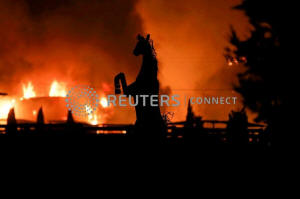Year's most destructive California wildfire declared extinguished after
two weeks
 Send a link to a friend
Send a link to a friend
 [November 08, 2019]
By Steve Gorman [November 08, 2019]
By Steve Gorman
(Reuters) - California's biggest, most
ruinous wildfire this year, a wind-driven blaze that scorched 120 square
miles (310 square kilometers) of Sonoma County wine country and consumed
scores of homes, was declared fully contained and extinguished on
Thursday, two weeks after erupting.
The Kincade fire alone accounts for nearly a third of the 250,000-plus
acres (101,000 hectares) laid to waste by blazes since January, many
during a series of violent windstorms of historic proportion that swept
California last month.
The tally of more than 400 structures damaged or destroyed in the
Kincade fire also represents over half the property losses from all
California wildfires this year, according to the California Department
of Forestry and Fire Protection, or Cal Fire.
Still, California's current fire season to date pales by comparison to
an epic spate of conflagrations in 2017 and 2018 that ranks as the
deadliest and most destructive in state history.

Nearly 150 lives were lost in wildfires during those two years,
including 85 who perished in the Camp fire, which virtually incinerated
the Northern California town of Paradise a year ago on Friday and stands
as the state's most lethal blaze on record. Cal Fire lists just three
wildfire fatalities so far this year.
Although weeks remain of a fire season that now effectively runs through
December, the 2019 tally of a quarter-million acres burned falls far
short of the 1.2 million acres and 1.6 million acres that went up in
flames in 2017 and 2018, respectively. Thousands of homes were
destroyed.
A number of factors have been cited for the reduced wildfire toll in
2019, including redoubled readiness and prevention efforts and favorable
weather through the first half of the year.
"We had a great winter, in terms of rainfall, with a really good snow
pack, and no winds to speak of for most of the year," Cal Fire spokesman
Scott McLean said.
[to top of second column]
|

A horse statue is silhouetted by a burning structure during the
wind-driven Kincade Fire in Windsor, California, U.S. October 27,
2019. REUTERS/Stephen Lam

Those conditions gave way to the onset of heavy blasts of dry,
gale-force winds blowing in from desert areas in October, the
traditional peak of fire season.
When fires did ignite, many communities in harm's way likely
benefited from having more "defensible space" thanks to greater
emphasis on fuel-reduction projects aimed at removing excess
vegetation that might otherwise burn.
Governor Gavin Newsom also allocated extra money to pre-stage
firefighting strike teams and equipment in strategic spots, allowing
local authorities to respond to fires more swiftly, McLean said.
The jury was still out on the success of another major change in
preparedness - increased use of wide-scale, precautionary power
shut-offs by utilities during high winds to reduce the risk of
electric lines sparking fires.
Pacific Gas and Electric Co. made particular use of this strategy in
October, cutting off electricity to millions of residents in a move
the governor and state regulators criticized as badly managed.
PG&E has acknowledged that the Kincade fire erupted near the base of
a damaged high-voltage transmission tower where one of its lines
malfunctioned about the time the blaze started, though the fire's
cause remains under investigation.
(Reporting by Steve Gorman in Culver City, California; editing by
Bill Tarrant and Sandra Maler)
[© 2019 Thomson Reuters. All rights
reserved.]
Copyright 2019 Reuters. All rights reserved. This material may not be published,
broadcast, rewritten or redistributed.
Thompson Reuters is solely responsible for this content.
 |